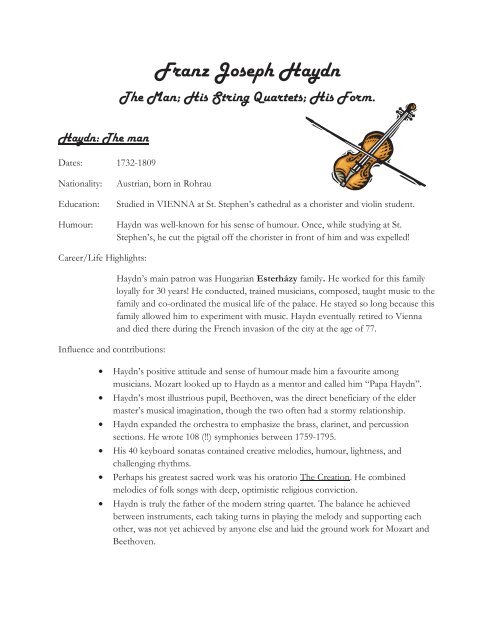Franz Joseph Haydn The Man; His String Quartets - macleanmusic
Franz Joseph Haydn The Man; His String Quartets - macleanmusic
Franz Joseph Haydn The Man; His String Quartets - macleanmusic
Create successful ePaper yourself
Turn your PDF publications into a flip-book with our unique Google optimized e-Paper software.
<strong>Franz</strong> <strong>Joseph</strong> <strong>Haydn</strong><br />
<strong>The</strong> <strong>Man</strong>; <strong>His</strong> <strong>String</strong> <strong>Quartets</strong>; <strong>His</strong> Form.<br />
<strong>Haydn</strong>: <strong>The</strong> man<br />
Dates: 1732-1809<br />
Nationality:<br />
Education:<br />
Humour:<br />
Austrian, born in Rohrau<br />
Studied in VIENNA at St. Stephen’s cathedral as a chorister and violin student.<br />
<strong>Haydn</strong> was well-known for his sense of humour. Once, while studying at St.<br />
Stephen’s, he cut the pigtail off the chorister in front of him and was expelled!<br />
Career/Life Highlights:<br />
Influence and contributions:<br />
<strong>Haydn</strong>’s main patron was Hungarian Esterházy family. He worked for this family<br />
loyally for 30 years! He conducted, trained musicians, composed, taught music to the<br />
family and co-ordinated the musical life of the palace. He stayed so long because this<br />
family allowed him to experiment with music. <strong>Haydn</strong> eventually retired to Vienna<br />
and died there during the French invasion of the city at the age of 77.<br />
• <strong>Haydn</strong>’s positive attitude and sense of humour made him a favourite among<br />
musicians. Mozart looked up to <strong>Haydn</strong> as a mentor and called him “Papa <strong>Haydn</strong>”.<br />
• <strong>Haydn</strong>’s most illustrious pupil, Beethoven, was the direct beneficiary of the elder<br />
master’s musical imagination, though the two often had a stormy relationship.<br />
• <strong>Haydn</strong> expanded the orchestra to emphasize the brass, clarinet, and percussion<br />
sections. He wrote 108 (!!) symphonies between 1759-1795.<br />
• <strong>His</strong> 40 keyboard sonatas contained creative melodies, humour, lightness, and<br />
challenging rhythms.<br />
• Perhaps his greatest sacred work was his oratorio <strong>The</strong> Creation. He combined<br />
melodies of folk songs with deep, optimistic religious conviction.<br />
• <strong>Haydn</strong> is truly the father of the modern string quartet. <strong>The</strong> balance he achieved<br />
between instruments, each taking turns in playing the melody and supporting each<br />
other, was not yet achieved by anyone else and laid the ground work for Mozart and<br />
Beethoven.
<strong>The</strong> <strong>String</strong> Quartet<br />
<strong>The</strong> string quartet is an intimate form of music. In <strong>Haydn</strong>’s time string quartets weren’t written to be<br />
played in large concert halls, but in small household settings. Often families would play string<br />
quartets together in the evenings.<br />
<strong>The</strong> typical string quartet has 2 violins, 1 viola, and 1 cello.<br />
<strong>The</strong> structure is similar to the classical symphony. It has 4 movements: the first and last movements<br />
are typically fast and in sonata-allegro form, the 2 nd movement is a slower movement, 3 rd movement<br />
is typically a minuet and trio.<br />
Let’s look at mv’t 1 and 2 of <strong>Haydn</strong>’s <strong>String</strong> Quartet in C major op. 76 no. 3 “<strong>The</strong> Emperor.<br />
1 st movement<br />
Sonata-allegro form. Allegro tempo. C major. Common time.<br />
Sonata-Allegro Form<br />
Sonata-allegro form is used in first and often last movements of many classical symphonies, quartets,<br />
and keyboard sonatas.<br />
It looks like this: AABA<br />
• Exposition (A): <strong>The</strong> main melody in the tonic key. A bridge that take us to a secondary key<br />
and a second, often contrasting, theme. <strong>The</strong> exposition is repeated.<br />
• Development (B): Where material from the exposition is changed or experimented with.<br />
This is where the composer’s creativity can come to life.<br />
• Recapitulation (A): Return of the two themes from the exposition, both in the tonic key this<br />
time. <strong>The</strong> movement ends with a coda (Italian meaning “tail”).<br />
Let’s listen to the first movement of <strong>The</strong> Emperor using our house diagram to follow the form.
2 nd movement<br />
<strong>The</strong>me and variations. 2/2 time. Poco adagio. G major.<br />
<strong>The</strong> theme is based on the hymn “God Preserve the Emperor Francis”. Hence the nickname for the<br />
quartet “<strong>The</strong> Emperor”!<br />
<strong>The</strong> theme is below. In your listening logs, describe the 4 variations. Indicate which instrument has<br />
the theme and how the theme has been altered.


